sri:
srimathE rAmAnujAya nama:
srimadh varavaramunayE nama:
sri vAnAchala mahAmunayE nama:
So far, we have observed the nature of chith (https://granthams.koyil.org/2013/03/06/thathva-thrayam-chith-who-am-i/) and achith (https://granthams.koyil.org/2013/03/thathva-thrayam-achith-what-is-matter/).
This article can be viewed as a presentation by clicking https://docs.google.com/presentation/d/1Q6qEuvsuGTv4z_5–HYzlLfRFkdprThj3xmqWoyqKCQ/present#slide=id.p.
Sources: thathva thrayam
srimathE rAmAnujAya nama:
srimadh varavaramunayE nama:
sri vAnAchala mahAmunayE nama:
So far, we have observed the nature of chith (https://granthams.koyil.org/2013/03/06/thathva-thrayam-chith-who-am-i/) and achith (https://granthams.koyil.org/2013/03/thathva-thrayam-achith-what-is-matter/).
This article can be viewed as a presentation by clicking https://docs.google.com/presentation/d/1Q6qEuvsuGTv4z_5–HYzlLfRFkdprThj3xmqWoyqKCQ/present#slide=id.p.
Understanding the Iswara thathvam (God) through the teachings of the wise men
We are continuing our journey in understanding the three entities (chith, achith, Iswara) through the divine grantham “thathva thrayam” (tattva trayam) of piLLai lOkAchAryar with the help of maNavALa mAmunigaL‘s beautiful commentary.
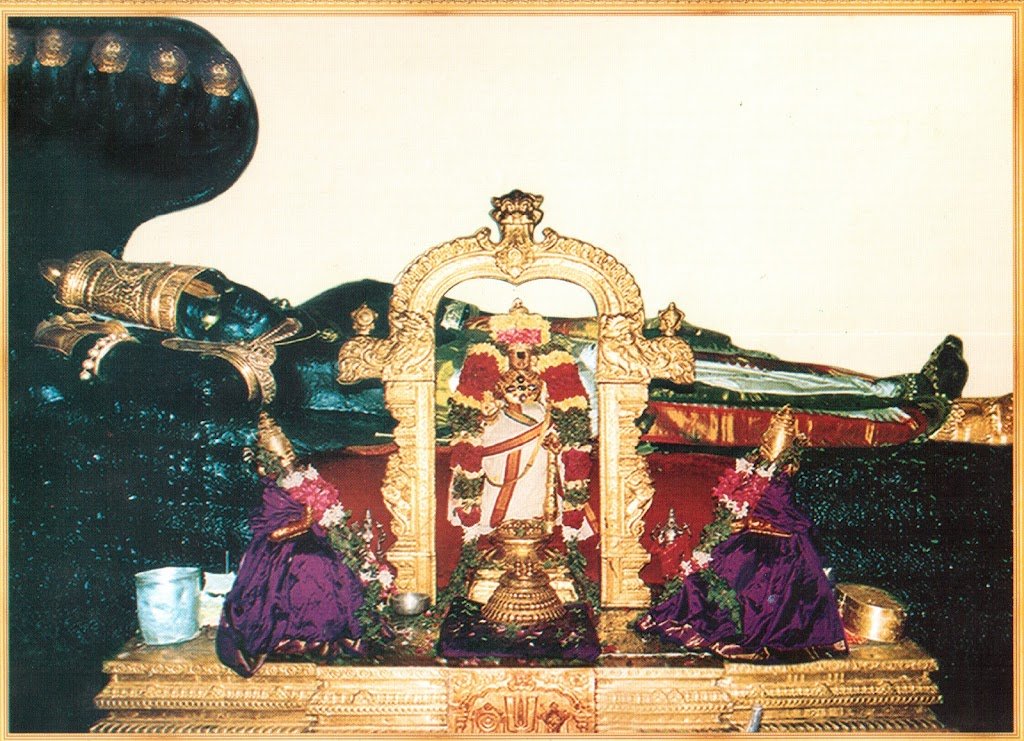
kaNNan emperumAn is glorified for his saulabhyam
srushti
sthithi
samhAram
bhagavAn‘s
Introduction

First emperumAn‘s
svarUpam (distinct nature) is explained in detail. Thathe is completely
different from all other entities is established right upfront.
svarUpam (distinct nature) is explained in detail. Thathe is completely
different from all other entities is established right upfront.
svarUpam – true nature
- By nature, ISwaran is
- not the
abode for any inauspicious qualities (meaning abode for all auspicious
qualities) - unbounded
by- time –
existence in past, present and future, - place –
everywhere in both spiritual and material worlds – all pervading nature
and - object – he
is the in-dwelling soul of all objects
- time –
- abode of
full knowledge and unlimited bliss - abode of
many auspicious qualities such as knowledge, strength, etc - the one who
fully manages creation, sustenance and dissolution - the one who
is the refuge for the 4 types of seekers (as identified in bhagavath
gIthai 7.16 by ka NNan
emperumAn himself)- Artha: –
the distressed - arthArthi –
the one who is looking for new wealth - jigyAsur –
the one who is looking for kaivalyam - gyAni – the
true devotee
- Artha: –
- the who can
bestow the four purushArthams (goals) – dharma, artha, kAma, mOksha - the one who
has many divine forms - the one who
is the dear lord of SrI
mahAlakshmi, bhUdhEvi and neeLA dhEvi
- not the
- He being the
in-dwelling (controlling) soul of all entities does not affect him in any
way, just like jIvAthmA (soul) does not get affected by the changing bodies.
His Auspicious qualities
- His most
divine auspicious qualities are- eternal –
they always exist - countless –
there are so many auspicious qualities - boundless –
even one of the qualities cannot be comprehended fully - causeless –
his divine qualities do not manifest due to external inducing, they
naturally exist - defectless
- unparalleled
– since emperumAn does not
have any one equal or greater, his qualities also do not have anything
equal or greater
- eternal –
- Three
categories of his auspicious qualities- Focussed on
the ones who are favourable towards him and his devotees- vAthsalyam
– motherly forbearance
- vAthsalyam
- Focussed on
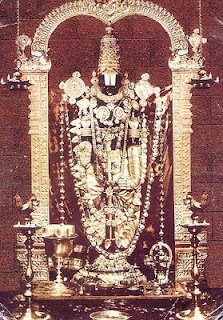
thiruvEnkatamudaiyAn
is often glorified for his vAthsalyam
is often glorified for his vAthsalyam
-
-
- sauseelyam
– magnanimity
- sauseelyam
-
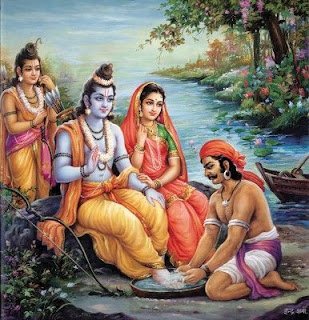

|
|
|
SrI rAman is glorified for his sauseelyam –
for mixing freely with guha, hanumAn, etc
for mixing freely with guha, hanumAn, etc
-
-
- saulabhyam
– easy accessibility
- saulabhyam
-
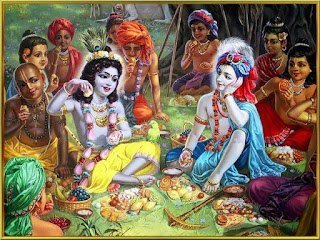
kaNNan emperumAn is glorified for his saulabhyam
-
-
- mArdhavam –
tenderness (of heart and body) - Arjavam –
honesty, etc
- mArdhavam –
-
-
- Focussed on
the ones who are unfavourable towards him and his devotees- sauryam –
valour/bravery - vIrya –
strength/power, etc
- sauryam –
- Common for
everyone- gyAna –
knowing about everything fully - shakthi –
strength - bala –
ability to support everything - aiSwarya –
controlling capacity - vIrya –
Even while managing everything, having no change in self (avikAra) - thEjas –
ability to handle everything individually
- gyAna –
- Focussed on
- Auspicious
Qualities and the target of those qualities- His gyAnam
(knowledge) is to help the ones who consider themselves to be ignorant - His shakthi
(strength) is to help the ones who consider themselves to be meek/humble - His kshamai
(forgiveness) is to help the ones who consider themselves to be commiting
offenses - His krupai
(mercy) is to help the ones who consider themselves to be suffering - His
vAthsalyam (motherly forbearance) is to help the ones who consider
themselves to to at fault - His seelam
(magnanimity) is to help the ones who consider themselves to be
downtrodden - His Arjavam
(honesty) is to help the ones who consider themselves to be dishonest - His
sauhArdham (good-heartedness) is to help the ones who consider themselves
to be not so good - His
mArdhavam (tender-heartedness) is to help the ones who cannot bear the
separation from bhagavAn - His
saulabhyam (easy accessibility) is to help the ones who desire to see him - and so on
- His gyAnam
- Manifestation
of his qualities- He shows
great concern towards the suffering jIvAthmAs (souls) and is constantly
looking for the well-being of them. - He
constantly tries to help them when they are in distress. - For the ones
who surrender unto him,- He does not
look at their defects which arise out of their birth, knowledge,
actions, etc. - He protects
them when neither they themselves can protect them nor others can
protect them. - He performs
miraculous activities to please them as he (kaNNan
emperumAn) did in the case of sAndhIpani muni (bringing back his dead son)
and the brAhmaNa (bring back his sons who were taken away by SrI
mahAlakshmi to paramapadham to have the divine vision of krishNan in
paramapadham). - He makes
himself fully available for them. - He feels
self satisfied after helping them as if his own personal task was
accomplished. - Without
considering the favours done by him, he looks out for the minimum
virtues done by the surrendered ones and helps them forget the taste for
material aspirations that is present in them since time immemorial. - He ignores
their mistakes like a man who ignores the mistakes of his dear wife and
children. - Even if SrI
mahAlakshmi points out the defects of the surrendered person, he simply
diregards them. - He consumes
their defects with great love, just like a man in love would like the
sweat etc., of his beloved. - In
separation, he feels greater distress compared to the surrendered ones. - Just like a
cow kicks out and pushes away the older calves when a new calf is born
out of great attachment and concern, emperumAn pushes
away SrI
mahAlakshmi and nithyasUris when a new jIvAthmA (soul) surrenders to him.
- He does not
- He shows
His kAraNathvam – He being the primordial cause
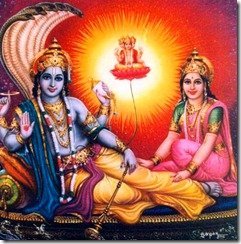
brahmA
(the first progenitor) being born from the navel of SrI mahAvishNu
(the first progenitor) being born from the navel of SrI mahAvishNu
- bhagavAn is
the cause of all the worlds. - Some say that
atom (lowest particle) is the primordial cause. - Since this is
contradictory to plain perception and SAsthram, they cannot be accepted as
the primordial cause. - Others say
matter is the primordial cause. - Since matter
does not have knowledge and does not transform on its own without the
intervention of bhagavAn, matter cannot be the primordial cause. - badhdha
chEthanas (jIvAthmA- individual soul) like brahmA, rudhran, etc cannot be
the primordial cause.Since they are bound by karmA and go through
sufferings, they cannot be the primordial cause. Thus ISwaran is the only
primordial cause. - He is being
the cause not due to ignorance, karmA, others’ orders etc but out of his
own desire and will. - Since
creation, sustenance and dissolution happen out of his own desire, there
is no suffering in these for him. - The whole
process is only for his pastime. - But would his
pastime be interrupted in samhAram (dissolution)? Since samhAram is also
part of his pastime, there is no interruption. mAmunigaL beautifully
shows a practical example – when children play with sand castles, at the
end of their play they knock down the castle as a part of the pastime with
full joy. Similarly, dissolution is also a pastime in bhagavAn’s
activities. - Since he
transforms his own body into this material world, he is the material
cause. Note: There are 3 causes: upAdhAna kAraNam (material cause),
nimiththa kAraNam (instrumental cause) and sahakAri kAraNam (supporting
cause). For example, in making a pot, sand and clay are the material
cause, the potter is the instrumental cause, his stick and wheel are the
supporting cause. - But since
there is no change to his svarUpam he is called nirvikAra (unchangeable). - It is only
his body (chith and achith) that gets transformed. Spider makes a web from
its own saliva and then it consumes it again. If a spider can do this, why
can’t ISwaran who is
omnipotent (capable of doing anything) do the same?
srushti, sthithi, samhAram
He is the full controller
of all these activities. samashti srushti (upto the creation of pancha
bhUthas) are done by bhagavAn himself directly and vyashti srushti (various
beings, manifestations, etc) are done indirectly by bhagavAn being the
antharyAmi of other beings.
of all these activities. samashti srushti (upto the creation of pancha
bhUthas) are done by bhagavAn himself directly and vyashti srushti (various
beings, manifestations, etc) are done indirectly by bhagavAn being the
antharyAmi of other beings.
srushti
(creation)
- srushti
involves- transforming
subtle matter into gross matter - providing
body and senses to jIvAthmAs - expanding
the knowledge of jIvAthmA
- transforming
- srushti is
done through brahmA, prajApathis, time and all beings by being present as
their in-dwelling soul. - srushti is
done in rajO guNam (the mode of passion).
sthithi
(sustenance)
- sthithi
involves- , sustainingjIvAthmAs
by being present within them with favourable intentions and helping them
in all different situations, just like water sustaining the crop in a
rice/paddy field
- , sustainingjIvAthmAs
- sthithi is
done by- descending
in many incarnations starting with vishNu (which is the first incarnation
in the material world) - establishing
SAsthram through manu, rishis, etc - guiding the
jIvAthmAs in good path - being
antharyAmi of time and all beings
- descending
- sthithi is
done in sathva guNam (the mode of goodness).
samhAram
(dissolution)
- samhAram
involves- pulling back
the jIvAthmAs into a subtle state to minimize their attachment to
material aspirations. This is similar to keeping one’s own uncontrollable
son under arrest for the well-being of the son.
- pulling back
- samhAram is
done by being the antharyAmi of rudhran, agni, time and all beings. - samhAram is
done in thamO guNam (the mode of ignorance).
bhagavAn‘s
supreme quality during srushti
- If some are
joyful and others are in distress, would that not reflect partiality and
cruelty in bhagavAn’s part? - Not at all –
since everyone gets his/her body based on his/her karmA, and all actions
are done to reform/uplift the jIvAthmA slowly into a higher state, there
is no partiality or cruelty in bhagavAn’s part. - bhagavAn
performs srushti, sthithi, samhAram with a divine form as stated by nammAzhwAr in 3.2.1.
bhagavAn‘s various forms
- emperumAn‘s forms are
- more
enjoyable than his svarUpam (nature), guNam (quality), etc. - eternal –
always with a form - uniform –
without the effects of old age etc - made of
auspicious matter which is in the mode of pure goodness - fully
revealing of his true nature unlike material body which covers the soul’s
knowledge. - eternally
glowing - abode of all
divine qualities like beauty, softness, etc - those which
are meditated upon by all yOgis - those which
will cease our attachment to everything else - which are
enjoyed by nithyasUris and mukthAthmAs - those which
remove all pains - source of
all incarnations - refuge for
everyone - abode for
everything - decorated
with divine weapons (conch, discus, etc) and ornaments (garlands,
necklaces, etc)
- more
- bhagavAn’s
svarUpam is attached with 5 different categories of forms namely- parathvam –
form in paramapadham - vyUham –
forms in vyUha state which is primarily focussed on the material worlds - vibhavam –
innumerable incarnations of emperumAn - antharyAmi –
in-dwelling soul in all jIvAthmAs (souls) and achEthanams (matter) - archai –
innumerable deity forms which are worshipped at temples, mutts, homes,
etc - These are
briefly discussed at https://granthams.koyil.org/2012/10/archavathara-anubhavam-parathvadhi/.
- parathvam –
parathvam
- paramapadham
is described as the place of endless bliss and innumerable auspicious
qualities and where kAlam (time) is not the controller. In samsAram time
is the controller – whether we want or not, time automatically transforms
every thing. - everything is
spiritual in paramapadham. - He along with
his divine consorts SrI mahAlakshmi, bhU dhEvi and neeLA dhEvi are the
prime focus. - He exists
there for the full enjoyment of nithya sUris (eternally free souls) and
mukthAthmAs (the souls who were bound in samsAram before but free now in
paramapadham). - His
auspicious qualities such as knowledge, strength etc are fully manifested
in paramapadham.
vyUham
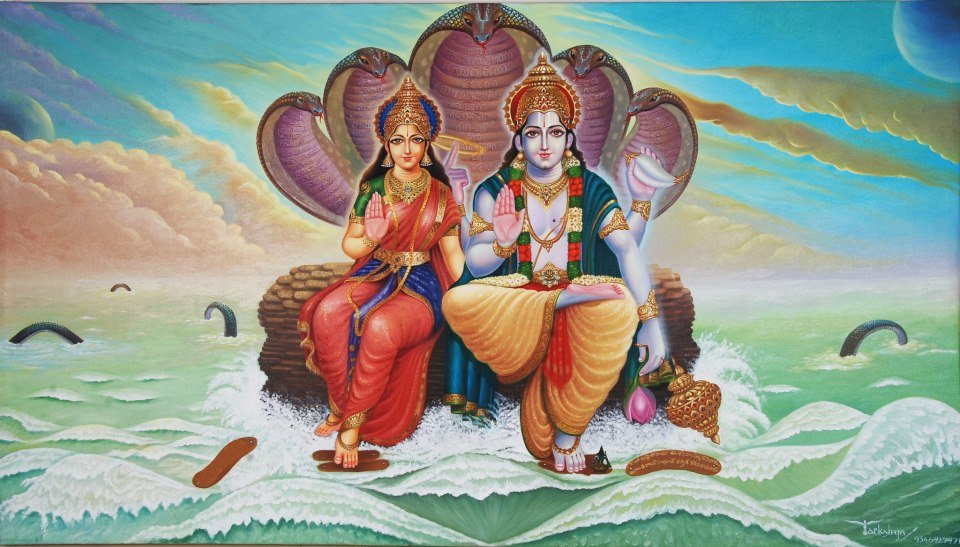
kShirAbdhi
nAthan is a representative of vyUha forms
nAthan is a representative of vyUha forms
- forms that
are accepted by bhagavAn- for the
purpose of maintaining order (thru srushti, sthithi, samhAram) in the
material worlds, - to
guide/nourish the jIvAthmAs in samsAram and - to be the
object of meditation for the meditators.
- for the
- para
vAsudhEvan first expands himself into vyUha vAsudhEvan. - vyUha
vAsudhEvan expands himself in to 3 more forms – sankarshaNa, pradhuymna
and anirudhdha. - sankarshaNa
- gyAnam
(knowlege) and balam (ability to support everything) are predominant in
him. - He presides
over the jIva thathvam (soul) and distinguishes between soul and matter,
and initiates the process of giving names and forms to them. - He is
responsible for establishing SAsthram (vEdham, vEdhAntham, etc) and
samhAram (dissolution). - He
subsequently expands into pradhyumna form.
- gyAnam
- pradhyumna
- aiSwarya
(controlling ability/wealth) and vIrya (power) are predominant in him. - He presides
over the manas thathvam (mind). - He is
responsible for- instructing
on the righteous principles - the
creation of human beings and chAthur varNams (four categories – brAmaNa,
kshathriya, vaisya, shUdhra) - the creation
of all who are focussed on the mode of goodness (which ultimately leads
to bhagavAn)
- instructing
- aiSwarya
- anirudhdha
- shakthi
(strength) and thEjas (ability to handle anything individually) are
predominant in him. - He is
responsible for- giving true
knowledge - creation of
time and all entitieswhich are in the mixed mode of goodness, passion
and ignorance.
- giving true
- shakthi
vibhavam

dhasAvathAram
– the 10 main incarnations
– the 10 main incarnations
- there are
innumerable incarnations of bhagavAn. - his
incarnations are categorised into- mukya
avathArams- these are
considered most important and worshippable for mumukshus (one who
desires for mOksham) - bhagavAn
himself descends in many divine forms such as mathsya, kUrma, varAha etc - the forms
are made of divine matter (just like in paramapadham). - he carries
all his auspicious qualities in full into these forms just like in
paramapadham. - just like a
lamp which is lit with a match stick glows more than the match stick,
his incarnations glow more than his form in paramapadham.
- these are
- gauNa
avathArams- gauNam
means giving his svarUpam (nature) or shakthi (strength) to jIvAthmAs to
fulfil specific goals. - these are
considered less important and not worshippable for mumukshus, because
the purpose of these avathArams is to fulfil specific tasks only. - two
categories- svarUpa
AvEsam – bhagavAn giving his divine svarUpam (nature) to jIvAthmAs and
descending with his divine form. Examples: parasurAma, etc. - shakthi
AvEsam – bhagavAn giving his powers alone to jIvAthmAs for specific
purpose. Examples: brahmA, rudhran, vyAsa, etc.
- svarUpa
- gauNam
- mukya
- he descends
into various incarnations purely by his divine desire. - the goal of
these incarnations is explained by bhagavAn himself in bhagavath gIthai
4.8 as- parithrANAya
sAdhUnAm – protecting his devotees (the virtuous) - vinASAya cha
dhushkruthAm – annihilating the evil-minded - dharma
samsthApanArtham – establishing the righteous principles
- parithrANAya
- Though at
times it is said that bhagavAn incarnates due to rishi’s curse, etc, those
are only pretext (false reason) and the real reason is his desire only.
antharyAmi

- antharyAmi
means being all pervaded and fully controlling all entities from within. - Wherever
jIvAthmAs go, bhagavAn also accompanies them to guide them. - For the ones
who want to meditate on bhagavAn, he mercifully appears with a divine form
and his divine consorts within their hearts. - He is
constantly protecting the jIvAthmAs by being with them within their heart.
archai

108
dhivya dhEsams – the ones which are glorified by AzhwArs
dhivya dhEsams – the ones which are glorified by AzhwArs
- this is
explained as the epitome of all the different forms of bhagavAn. - As poigai AzhwAr identified
in mudhal thiruvanthAdhi 44th pAsuram, emperumAn happily accepts the form
that is desired by his devotees. - archAvathAram
is present at all places and at all times to everyone unlike other forms
(param, vyUham, etc) which are limited to- certain
dhEsam (places like paramapadham, kshIrAbdhi etc) - certain
kAlam (time like thrEthA yugam, dhvApara yugam etc), - certain
adhikAris (persons like dhaSarathan during rAmAvathAram etc)
- certain
- He ignores
the faults/mistakes of his worshippers due to his causeless mercy. - He fully
depends on his worshippers for all of his actvities (like bathing, eating,
sleeping etc). - He descends
into many temples (dhivya dhEsams, abhimAna kshEthrams, village temples,
etc – everywhere irrespective of city, country, continent, planet, etc),
mutts and our own homes. - Complete
nature of archAvathAram- He creates
the taste and attachment towards him through his archAvathAram. - He is the
abode of all auspicious qualities – all his qualities such as sauseelyam
(magnanimity), saulabhyam (easy accessibility), vAthsalyam (motherly
forbearance) etc are fully manifested and visible here. These qualities
are subdued in paramapadham, since everyone is pure and fully realised in
paramapadham. - He is the
refuge for everyone irrespective of his birth, knowledge etc. - He is the
most enjoyable as explained fully by AzhwArs and AchAryas. We have
already enjoyed AzhwAr/AchAryas archAvathAra anubhavam in https://granthams.koyil.org/archavathara-anubhavam-english/.
- He creates
- His
magnanimous nature in archAvathAram- Even though
he is the master and everyone else is dependent on him, he manifests
himself as the dependent and fully dependent on his devotees. - Being in a
deity form, he presents himself to be- ignorant –
since he understands everything through his devotees - incapable –
since he waits for his devotees for all of his actions like bathing,
eating, dressing, sleeping etc - fully
dependent on his devotees as explained above
- ignorant –
- Still, out
of his causeless and unlimted mercy, attachment and compassion towards
his devotees, he fulfills all their desires without expecting anything
back, thus manifesting his great quality called vAthsalyam (motherly
forbearance)
- Even though
Conclusion
Thus we have seen the 3
entities namely chith, achith and ISwara in
fair (detail. This is one of the most difficult subject matters since it
involves many technical and in-depth aspects. We have seen the tip of the
iceberg – there is so much more relishable explanations in mAmunigaL‘s
vyAkyAnam for this divine grantham thathva thrayam of piLLai
lOkAchAryar which is called kutti bhAshyam (the essence of emperumAnAr‘s
SrI bhAshyam). Let us glorify our SrIman
nArAyaNan, AzhwArs
and AchAryas
for providing us with these great literatures which are more valuable than
anything else for us.
entities namely chith, achith and ISwara in
fair (detail. This is one of the most difficult subject matters since it
involves many technical and in-depth aspects. We have seen the tip of the
iceberg – there is so much more relishable explanations in mAmunigaL‘s
vyAkyAnam for this divine grantham thathva thrayam of piLLai
lOkAchAryar which is called kutti bhAshyam (the essence of emperumAnAr‘s
SrI bhAshyam). Let us glorify our SrIman
nArAyaNan, AzhwArs
and AchAryas
for providing us with these great literatures which are more valuable than
anything else for us.

piLLai lOkAchAryar, maNavALa mAmunigaL – srIperumbUthUr
adiyen is grateful to Sri U.Ve. P B Sampath swamy who taught thathva thrayam (both the text and meanings) to adiyen.
SrImathE
ramyajAmAthru munIndhrAya mahAthmanE
ramyajAmAthru munIndhrAya mahAthmanE
SrIrangavAsinE
bhUyAth nithyaSrIr nithya mangaLAm
bhUyAth nithyaSrIr nithya mangaLAm
mangaLASAsana parair
madhAchArya purOgamai:
sarvaischa pUrvair AchAryai satkruthAyAsthu mangaLam
madhAchArya purOgamai:
sarvaischa pUrvair AchAryai satkruthAyAsthu mangaLam
AzhwAr
emperumAnAr jIyar thiruvadigaLE SaraNam
emperumAnAr jIyar thiruvadigaLE SaraNam
jIyar
thiruvadigaLE SaraNam
thiruvadigaLE SaraNam
AchAryan
thiruvadigaLE SaraNam
thiruvadigaLE SaraNam
adiyen sarathy ramanuja dasan
Sources: thathva thrayam
archived in https://granthams.koyil.org, also visit https://acharyas.koyil.org

Swami, regarding this section:
"The whole process is only for his pastime.
But would his pastime be interrupted in samhAram (dissolution)? Since samhAram is also part of his pastime, there is no interruption. mAmunigaL beautifully shows a practical example – When children play with sand castles, at the end of their play they knock down the castle as a part of the pastime with full joy. Similarly, dissolution is also a pastime in bhagavAn's activities."
Sri Kanchi Swami has beautifully pointed out the mEdhAvilAsam of mAmunigal. Actually, both udayavar and ulagAriyan say, "shrShti, etc is for the purpose of leela". According to Kanchi Swami, mAmunigal was not satisifed with the wording of thse pUrvAcHAryAs. After all, shrShti itself is a leela, so how can one say it is for the purpose of leela, as though leela is earned by the work of shrShti? At the same time, our periya jeeyar, being charamOpAya nishtar, did not want to openly point out that ulagAriyan and udayavar's phrasing was somewhat inadequate and he did not want to show his own intelligence by writing an explanation.
So, very ingeniously, our "poi illAdha manavAla mAmunigal" raised a pUrvapaksha – "would this leela be interrupted in samhAra?" and in the guise of answering that pUrvapaksha, included that observation of samhArA itself being a leela. This completed the explanation of the previous AchAryAs and pEriya jeeyar disguised his own observation as though it is a well known answer of the above AchAryAs as well!
This only highlights the great intellect of jeeyar as well as his charamOpAya nishtai. Sri Kanchi Swami asks, out of the hundreds of vidwAns and AchAryAs, who else but mAmunigal alone would have had the keen intellect to identify this issue? So many vidwAns have read udayavar and ulagAriyan's statements, but it was only mAmunigal who identified a potential issue to be addressed. And who other than Jeeyar would answer it so beautifully with charamOpAya nishtai?
And who else but Kanchi Swami could point this out?
maNNu pugazh manavAla mAmuniyE innum oRu nURRandu irum!
dasan,
Srinivasan.
dear swamy,
thanks for expanding the beautiful point with insights from kAnchi swamy's wonderful works.
adiyen sarathy ramanuja dasan
In hindi: https://granthams.koyil.org/2016/08/05/thathva-thrayam-iswara-who-is-god-hindi/
In thamizh – https://granthams.koyil.org/2017/10/12/thathva-thrayam-iswara-who-is-god-tamil/
In kannada – https://granthams.koyil.org/2022/01/07/thathva-thrayam-iswara-who-is-god/